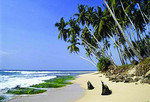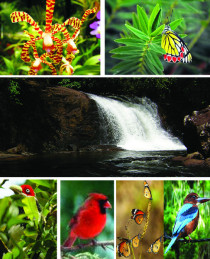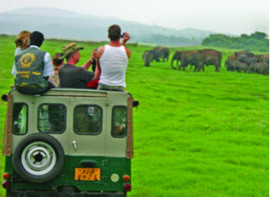Adam’s Peak
Adam's Peak is known locally as "Sri Pada" and is Sri Lanka's fourth highest mountain at 2,243 metres. It is one of the island's most important pilgrimage sites and is situated in the Ratnapura district. The giant footprint at the top is the attraction and is sacred to Buddhists, Hindus and Muslims. The conical shaped mountain is worth the climb for the views and spiritual experience regardless of your belief.
Most do the walk from the shorter Dalhousie route by moonlight arriving in time to see the sunrise and the shadow it casts behind the peak toward the west. You need to leave around 3 to 4 hours for the climb. It does get cold at the top so warm clothing and a sleeping bag is advised.
Sri Lankan Beach
Even the white sandy beaches of Sri Lanka's southern coast to lure a day trip. Popular among other things the resort of Unawatuna. We recommend, however, Mirissa. Its beautiful beach is cleaned daily, and the police are on beach safety. You can also make a small day tour from there to Matara and visit the historic fort.
Galle Fort
Galle Dutch Fort UNESCO world heritage site on Sri Lanka south coast remains the best preserved fortified city build by European colonial powers in Asia. A century after Portuguese established Galle Fort, the Dutch developed Galle fort to its present grandeur. British were only the last in a long line of European colonial rulers.
Sinharaja Rainforest
Large-flowered orchids, carnivorous plants and an abundance of wildlife await visitors. The approximately 88 square mile reserve in 1989 by UNESCO World Heritage Site. The excursion lasts about 5 - 6 hours including picnic.
You arrive in a vehicle. The last meters to the edge of the rain forest we set foot back (about 40 minutes).
Then it goes through a stunning flora and fauna. A waterfall, we invite you to picnic. Here you can swim. (Please do not forget bathing suits.)
The return journey - among others over a suspension bridge - offer another intriguing prospect.
Yala National Park
Yala National Park is the most visited and second largest National Park in Sri Lanka. Actually it consists of five blocks, two of which are now open to the public; and also adjoining parks. The blocks have individual names also, like Ruhuna National Park for the (best known) block 1 and Kumana National Park or 'Yala East' for the adjoining area. It is situated in the southeast region of the country, and lies in Southern Province and Uva Province. The park covers 979 square kilometres (378 sq mi) and is located about 300 kilometres (190 mi) from Colombo. Yala was designated as a wildlife sanctuary in 1900, and, along with Wilpattu it was one of the first two national parks in Sri Lanka, having been designated in 1938. The park is best known for its variety of wild animals. It is important for the conservation of Sri Lankan Elephants and aquatic birds.
Tea in the world
1840 the East India Company planted the first tea plant in Sri Lanka, and in 1849 the first tea plantations were created. Tea picking is in Sri Lanka a traditional work of women. The transformation of a green leaf in black tea is a refined art and pedantic. Freshly harvested tea has between 15-25 hours to dry the air, before the leaves, rolled and fermented zerwalzt be. Four pounds of leaves creates a pound of tea. The best-known teas Pekoe (Grand twisted black leaves), orange pekoe (turned long thin leaves), chunks Orange Pekoe (buds and leaves), Fanning (Granular, small leaves) are. Tea Experts describe aroma and flavor of tea - just like the wine - in diverse embellishments.
Bundala National Park
Bundala National Park is an internationally important wintering ground for migratory water birds in Sri Lanka. Bundala harbors 197 species of Birds, the highlight being the Greater Flamingo, which migrate in large flocks. Bundala was designated a wildlife sanctuary in 1969 and redesignated to a national park on 4 January 1993. In 1991 Bundala became the first wetland to be declared as a Ramsar site in Sri Lanka. In 2005 the national park was designated as a biosphere reserve by UNESCO, the fourth biosphere reserve in Sri Lanka.
Udawalawe National Park
The national Park was created to provide a sanctuary for wild Animals displaced by the construction od the Udawalawe Reserve on the Walawe River, as well as to protect the catchment of the reservoir. The reserve covers 30,821 Hectares (119.00 sqm) of land area and was estabtished on 30th Kune 1972. The Park is 165 Kilometers from Colombo. Udawalawe lies on the Boundary of Sri Lankas wet and dry zones. Plains dominate the topography, though there are also some mountainous areas. The Kalthota Range and Diyawini Falls are in the north of the park and the outcrops of Bambaragala and Reminikotha lie within it. Udawalawe is an important habitat for water birds and Sri Lankan Elephants. It it a popular Tourist Destination and the third most visited park in the Country.













